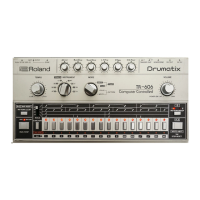switch for step #12, and then release the FUNCTION button (J). You have just set a
12 Step pattern using a #3 Scale.
With the TRACK/INSTRUMENT selector (C), choose the sounds you need to
program the Program Score #2 as shown in Fig. 5. Program this Rhythm as you had
done in Program Score #1. Programming of I and II PATTERN GROUPs (N) is done
in the same manner, the sole difference being the position of the PATTERN GROUP
switch (N) during the programming.
Writing Chained Rhythm Patterns
The Chained Rhythm Pattern can be selected in the PATTERN WRITE MODE while
the Rhythm is stopped. This is done the same way as was done in the PATTERN
PLAY Mode, by simultaneously pressing and two of the SELECTOR Switches (K)
within a group (1-4, 5-8, 9-12 or 13-16). As we said before, Chained Rhythm Patterns
can be used to create Rhythm Patterns of two or more measures in length or to create
Rhythm Patterns in odd time signatures.
Chained Rhythm Patterns are also mentioned in CHAINING RHYTHM PATTERNS
(See Basic Course)
We will now program the following Rhythm Patterns using two Rhythm Patterns
chained together. Stop the Rhythm and set the MODE selector (B) to PATTERN
WRITE. Press SELECTOR Switches (K) 1 and 2 simultaneously, and while holding
them down, press the CLEAR/RESET button (F).
Release all buttons, and the two Patterns will be cleared. Start the Rhythm, the TR-
606 runs from #1 to #2 and back to #1. Set the SCALE switch (I) to 2 and push the
FUNCTION button (J). While holding the FUNCTION button (J) down, press
SELECTOR Switch (K) #16 to set a sixteen step pattern in #1 position. Repeat the
same procedures while the Rhythm runs to #2 position to set the same SCALE and
STEP Number. You have just set up a Rhythm Pattern that extends over two Selector
positions which gives you a total of 32 steps for the measure (each step now
corresponding to a thirty-second note). TAP programming is easier in this case than
Step programming.
[This is because when pattern 2 is playing, you can't edit pattern 1, and vice versa. If
you turn the tempo down as low as it goes, step programming isn't too hard any more,
but then you lose the flow of the track if you're playing live. Check out
live.txt
for
some hints on using these functions in a live situation - ed]
Program the following Rhythm Program Score (Shown in Fig. 6)
Fig. 6
1234567890123456 1234567890123456
BD x-----x--------- --------x-------
SD ----------x----- x---------------
LT ---------------- --------x-------
OH x--------------- ----x-------x---
CH -xxxxxxxx-x-x-x- x-x---x-x-x---x-
AC x-----x-x------- x-------x-------

